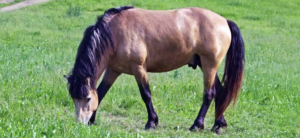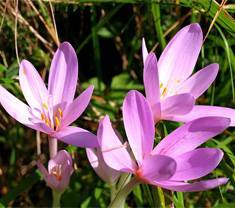 Toxic Plants for Horses: Meadow Saffron – Why are horses entice by it? Some owners find tranquility in watching their horses graze. Others size up the same scene with uncertainty, even worry, as they tally the potential dangers that lurk in fields and fencerows: buttercups, acorns, red maple leaves, and black walnut bark. Which level of concern is most fitting? A new study on “poison preference” suggests that the reality may lie somewhere between blissful ignorance and unflagging vigilance.*
Toxic Plants for Horses: Meadow Saffron – Why are horses entice by it? Some owners find tranquility in watching their horses graze. Others size up the same scene with uncertainty, even worry, as they tally the potential dangers that lurk in fields and fencerows: buttercups, acorns, red maple leaves, and black walnut bark. Which level of concern is most fitting? A new study on “poison preference” suggests that the reality may lie somewhere between blissful ignorance and unflagging vigilance.*
What is Meadow Saffron?
Meadow saffron is also known as autumn crocus because of its fall-flowering habit. Furthermore, it’s widely dispersed throughout Europe. In addition, it’s in many areas of the United States, notably Kentucky, Maryland, New York, North Carolina, Vermont, New Hampshire, Oregon, and Utah.**
 Above all, the meadow saffron is not a true crocus, like those that come as signals of spring. As meadow saffron grows, broad leaves erupt from the ground, similar to those of the more familiar garden tulip. In early fall, once the leaves have died back, flowers erupt from the corms. As this photograph taken by Enrico Blasutto shows, each stalk produces a single flower that is typically light pink or purple. All parts of the plant are toxic.
Above all, the meadow saffron is not a true crocus, like those that come as signals of spring. As meadow saffron grows, broad leaves erupt from the ground, similar to those of the more familiar garden tulip. In early fall, once the leaves have died back, flowers erupt from the corms. As this photograph taken by Enrico Blasutto shows, each stalk produces a single flower that is typically light pink or purple. All parts of the plant are toxic.
The plant contains a substance called colchicine that inhibits cell division when eaten, potentially causing severe clinical signs. The gastrointestinal system associates with many signs of toxicity. For example, excessive salivation, difficulty swallowing, abdominal pain, and diarrhea.+ In addition, bloody urine and coughing have also been observed in horses.
Study Results:
In the study, a veterinary research team offered hay contaminated with meadow saffron to six mature horses, expecting them to avoid the poisonous plant. To their surprise, none of the horses steered clear of the meadow saffron despite having clean, uncontaminated hay available at all times.
“The behavior of these horses shows sharp contrast to the widely held belief that horses will voluntarily avoid toxic plants when safe plants are available,” said Catherine Whitehouse, M.S., a Kentucky Equine Research nutritionist.
“This study offered free-choice good-quality hay. As a result, suggesting that the intake of meadow saffron was likely not due to hunger but perhaps curiosity,” Whitehouse explained. “Most horses investigated and consumed the meadow saffron at the beginning of the feeding period and less so as the study progressed.”
Why were those horses enticed by the meadow saffron? According to the study, a variety of sensory cues. Therefore, taste preferences, and experiences all influence what a horse will and won’t consume.
“The bitter taste of meadow saffron may be palatable to horses,” she said. Colchicine and similar plant products have bitter flavors, often considered a protective mechanism for plants against grazing animals. Indeed, some studies show that horses seem to prefer—or are not put off by—bitter flavors, like fenugreek.
“Surpisingly, the odor of meadow saffron attracted horses. During the study, horses displayed investigative movements with their nostrils before ingesting the meadow saffron,” Whitehouse said.
Feed Composition:
Feed composition may provide another potential explanation why the horses preferentially consumed the poisonous plant. Horses reportedly prefer feeds rich in carbohydrates (sugars) and protein. The meadow saffron used in this study had higher crude protein and lower fiber fractions than the safe hay, which potentially increased palatability.
“In addition to the willingness of horses to consume toxic plants, this study shows that owners should carefully evaluate pastures and hay prior to feeding their horses,” Whitehouse advised.
In one case report from Europe, three horses developed colic within a few days of consuming hay that was heavily contaminated with meadow saffron. One of the horses died, and the necropsy revealed an abundance of hemorrhagic fluid in the thorax and abdomen. Thereupon, toxicology uncovered colchicine overload.++
Importance of Vitamin E:
In addition, when worrying what is in dried hay, be sure to consider what isn’t. “Above all, dried forages are frequently low in vitamin E. As a result, horses fed all-forage diets that do not include fresh forage should be supplemented,” explained Whitehouse. “When choosing a vitamin E supplement, look for a product with proven bioavailability.”
For example, Nano-E is a water-soluble formulation that features advanced nanotechnology. Above all, it supplies a rapidly absorbed natural-source of vitamin E.
In conclusion, questions about Toxic Plants for Horses: Meadow Saffron? Contact us at J & J Hay Farms by clicking here!
Resources:
Article by: Kentucky Equine Research
*Mueller, C., L. Sroka, M.-L. Hass, S. Aboling, A. These, and I. Vervuert. 2021. Rejection behaviour of horses for hay contaminated with meadow saffron (Colchicum autumnale L.). Journal of Animal Physiology and Animal Nutrition:13648.
**USDA, NRCS. 2022. PLANTS Database. Colchicum autumnale L. National Plant Data Team. Accessed March 6, 2022.
+Cortinovis, C., and F. Caloni. 2015. Alkaloid-containing plants poisonous to cattle and horses in Europe. Toxins 7:5301-5307.
++Kamphues, J., and H. Meyer. 1990. Meadow saffron (Colchicum autumnale) in hay and colic in horses. Tierarztl Praxis 18(3):273-275.
